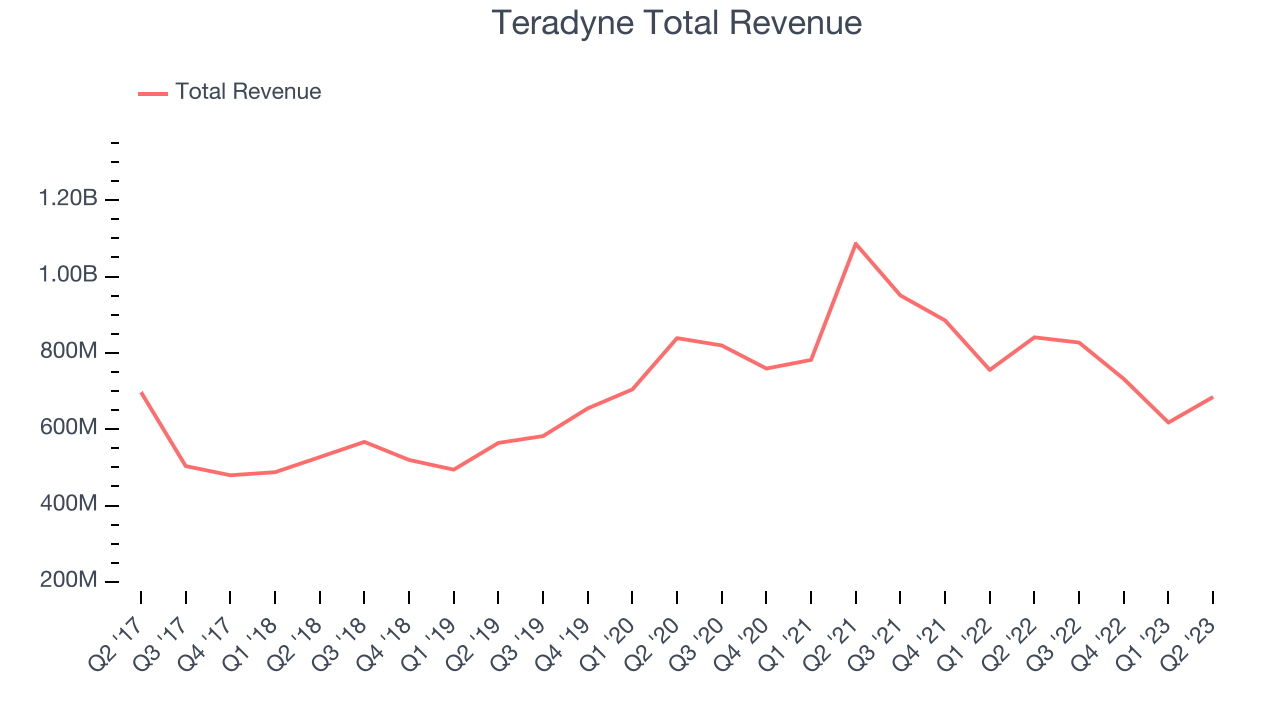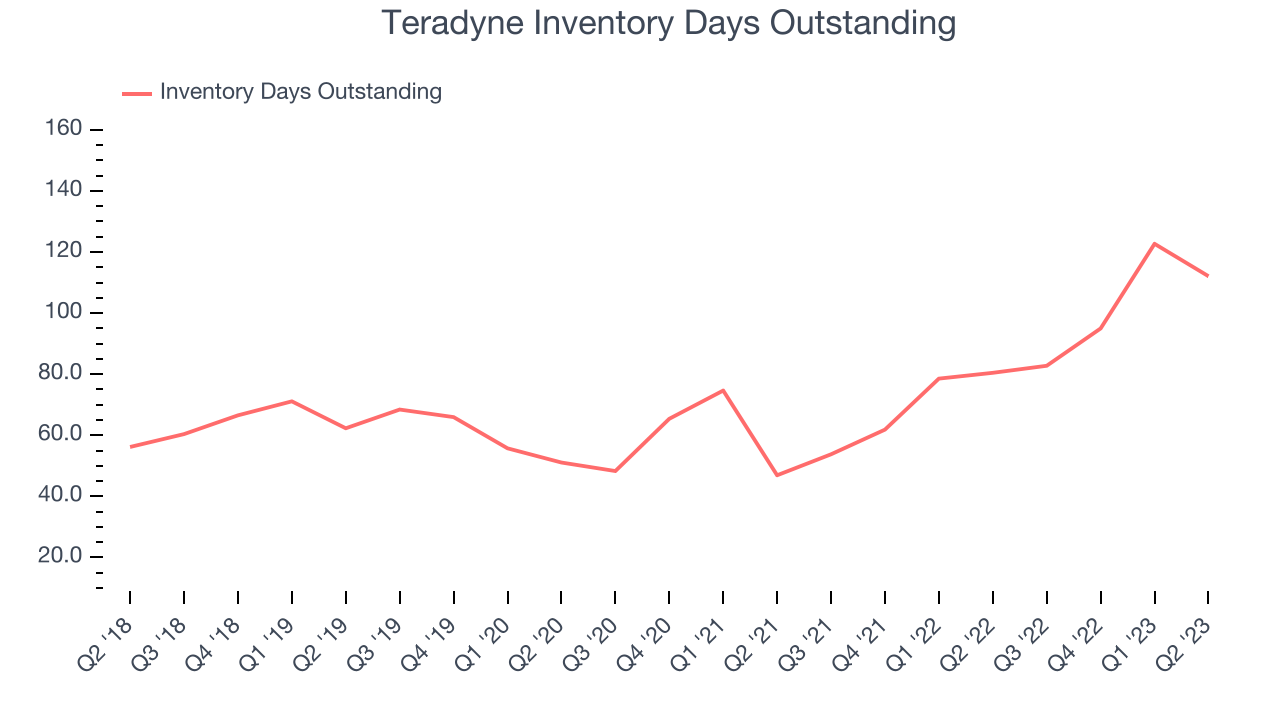Semiconductor testing company Teradyne (NASDAQ:TER) reported Q2 FY2023 results exceeding Wall Street analysts' expectations, with revenue down 18.6% year on year to $684.4 million. Guidance for next quarter's revenue was also better than expected $680 million at the midpoint, 1.27% above analysts' estimates, although non-GAAP EPS guidance was slightly below. Teradyne made a GAAP profit of $120.1 million, down from its profit of $197.8 million in the same quarter last year.
Is now the time to buy Teradyne? Find out by accessing our full research report free of charge.
Teradyne (TER) Q2 FY2023 Highlights:
- Revenue: $684.4 million vs analyst estimates of $658.1 million (4% beat)
- EPS (non-GAAP): $0.79 vs analyst estimates of $0.66 (20.1% beat)
- Revenue guidance for Q3 2023 is $680 million at the midpoint, above analyst estimates of $671.5 million
- Free cash flow of $103.5 million is up from -$22.1 million in the previous quarter
- Inventory Days Outstanding: 112, down from 123 in the previous quarter
- Gross Margin (GAAP): 58.8%, down from 60.2% in the same quarter last year
“We delivered revenue at the high end of our guidance range with higher semiconductor test shipments which more than offset weaker robotics demand in the quarter while profits exceeded plan on higher gross margins,” said Teradyne CEO Greg Smith. “As we enter Q3, test demand for DRR5 and HBM memory devices for data center applications remains strong and SOC test demand for automotive applications is incrementally stronger. In robotics, we expect order rates to decline as customers navigate slowing global industrial activity and macro-economic headwinds.”
With most major chip manufacturers as customers, Teradyne (NASDAQ:TER) is a US-based supplier of automated test equipment for semiconductors as well as other technology and devices.
The semiconductor industry is driven by demand for advanced electronic products like smartphones, PCs, servers and data storage. The growth of data and technologies like artificial intelligence, 5G networks and smart cars are also creating a next wave of growth for the industry. To keep up with ever changing customer needs requires new tools that can design, fabricate and test at ever smaller sizes and more complex architectures, and that is driving the demand for semiconductor capital manufacturing equipment.
Sales Growth
Teradyne's revenue growth over the last three years has been unimpressive, averaging 3.06% annually. This quarter, its revenue declined from $840.8 million in the same quarter last year to $684.4 million. Semiconductors are a cyclical industry, and long-term investors should be prepared for periods of high growth followed by periods of revenue contractions (which can sometimes offer opportune times to buy).

Even though Teradyne surpassed analysts' revenue estimates, this was a slow quarter for the company as its revenue dropped 18.6% year on year. This could mean that the current downcycle is deepening.
Teradyne's revenue growth has slowed over the last three quarters and its management team projects growth to turn negative next quarter. As such, the company is guiding for a 17.8% year-on-year revenue decline, but Wall Street thinks there will be a recovery next year. Consensus estimates call for 7.07% growth over the next 12 months.
In volatile times like these, we look for robust businesses with strong pricing power. Overlooked by most investors, this company is one of the highest-quality software companies in the world, and its software products have been the gold standard in critical industries for decades. The result is an impressive business that's up an incredible 18,000%+ since its IPO. You can find it on our platform for free.
Product Demand & Outstanding Inventory
Days Inventory Outstanding (DIO) is an important metric for chipmakers, as it reflects a business' capital intensity and the cyclical nature of semiconductor supply and demand. In a tight supply environment, inventories tend to be stable, allowing chipmakers to exert pricing power. Steadily increasing DIO can be a warning sign that demand is weak, and if inventories continue to rise, the company may have to downsize production.

This quarter, Teradyne's DIO came in at 112, which is 41 days above its five-year average. These numbers suggest that despite the recent decrease, the company's inventory levels are higher than what we've seen in the past.
Key Takeaways from Teradyne's Q2 Results
With a market capitalization of $18.2 billion, a $708.4 million cash balance, and positive free cash flow over the last 12 months, we're confident that Teradyne has the resources needed to pursue a high-growth business strategy.
We were impressed by how significantly Teradyne blew past analysts' earnings per share (EPS) expectations this quarter, driven by a nice revenue beat and even stronger non-GAAP operating profit beat. We were also glad that its inventory levels shrunk. On the other hand, although margins beat expectations, they are deteriorating year-on-year. Also while next quarter's revenue guidance was ahead, non-GAAP EPS guidance was slightly below expectations. Overall, this quarter's results were not perfect but still seemed fairly positive . The stock is up 1.84% after reporting and currently trades at $116.75 per share.
So should you invest in Teradyne right now? When making that decision, it's important to consider its valuation, business qualities, and what's happened in the latest quarter. We cover this and more in our full company report, and it's free.
Looking for more investment opportunities? One way to find them is to watch for paradigm shifts, just like how every company in the world is slowly becoming a technology company and facing increasing cybersecurity risks. This company is leading the charge in cyber defense with its cloud-native cybersecurity solutions while generating best-in-class revenue growth and SaaS performance metrics. It should definitely be on your radar.
The author has no position in any of the stocks mentioned in this report.
